Epidemiology Reviews Vol 18 No 2 John Hopkins
Coronavirus Research
Johns Hopkins Medicine researchers are working tirelessly to find means to better sympathise, treat and somewhen eliminate COVID-19 and the illness that results from infection. New discoveries and observations from Johns Hopkins that we share here, especially those related to clinical therapies, are almost uniformly early in concept. They will require rigorous research, testing and peer review before solid conclusions for clinical care and disease prevention tin be fabricated.
In addition, Johns Hopkins researchers are conducting a variety of clinical trials to find new ways to find, prevent and treat COVID-nineteen. These trials include studies involving Johns Hopkins employees, people who have COVID-19 and analysis of collected data most the disease. Results of these clinical trials will be bachelor when information is analyzed, peer-reviewed and published.
Sign Upwardly for Coronavirus (COVID-19) Electronic mail Alerts
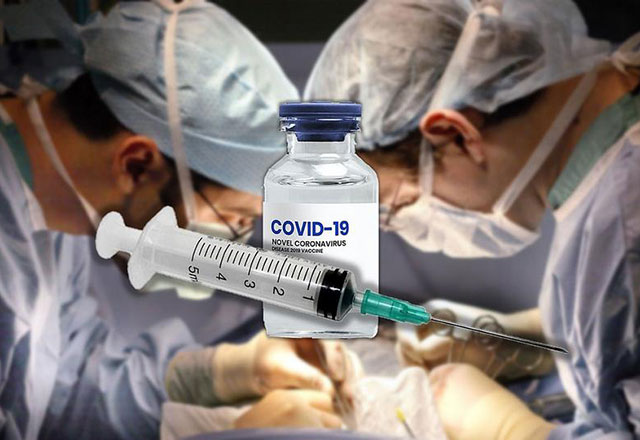 Credit: Graphic created by M.E. Newman, Johns Hopkins Medicine, with public domain images and groundwork transplant surgery photograph courtesy of Johns Hopkins Medicine
Credit: Graphic created by M.E. Newman, Johns Hopkins Medicine, with public domain images and groundwork transplant surgery photograph courtesy of Johns Hopkins Medicine
Organ Transplant Recipients and COVID-nineteen Vaccines
In a series of studies, Johns Hopkins Medicine researchers showed that although two doses of a vaccine against SARS-CoV-two — the virus that causes COVID xix — confers some protection for people who accept received solid organ transplants, it's yet not enough to enable them to manipulate with masks, physical distancing and other safety measures.
The research was published in several articles in the Journal of the American Medical Association.
Read more about the studies that testify the vaccine's effect in these patients and how a tertiary dose may help.
Engagement Posted: May 5, 2021 | Disclaimer
Play Video:
Rapid, Betoken-of-Intendance, SARS-CoV-2 Antibiotic Exam based on Hemagglutination
This point-of-intendance exam to discover SARS-CoV-two antibodies was adult by researchers at Johns Hopkins Academy School of Medicine. The test is demonstrated by an individual vaccinated against SARS-CoV-ii, resulting in efficient detection within iii minutes.
Researchers Design Blood Test to Confirm COVID-nineteen Vaccination
Johns Hopkins researchers take developed a rapid blood examination that may exist able to ostend within minutes if a person has been vaccinated while they wait to lath a plane or enter a sporting event. The researchers used technology similar to what is used in at-home tests to determine blood blazon, where the user pricks a finger and places a drop of blood on a carte du jour.
Results of studies using the test on 400 blood samples are currently being peer-reviewed.
Read more than near the inquiry
Date Posted: June three, 2021 | Disclaimer
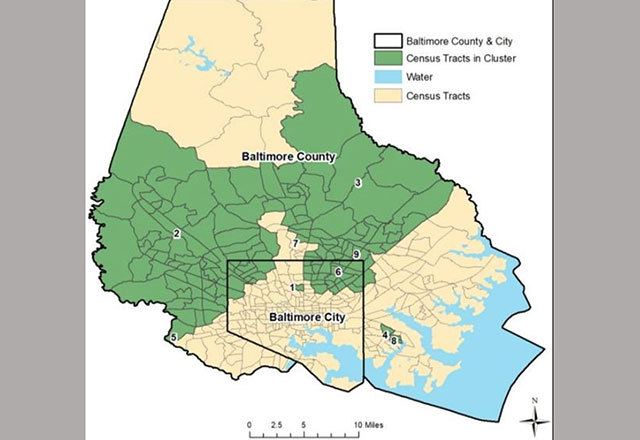 Credit: Robert Stevens
Credit: Robert Stevens
Mobile App Tracks COVID-19 Outbreaks
Tin can scientists predict a COVID-xix outbreak? It turns out in that location'due south an app for that. Johns Hopkins Medicine scientists launched the "COVID Control" app, which uses crowd-sourced data on COVID-nineteen symptoms to identify where outbreaks will announced.
While studying the app, the Johns Hopkins squad has looked at how user-reported COVID-19 symptoms can predict potential outbreaks, enabling public health leaders to enact measures to contain the virus' spread.
More than than 19,000 users in 1,019 counties in every state across the U.S. have logged more than 174,000 information entries to anonymously report symptoms. A closer await at the data showed that the app's reports from people in Baltimore City and Baltimore Canton in Maryland correlated with locations of increased COVID-nineteen prevalence.
Read more about our research in our Newsroom
Date Posted: May 5, 2021 | Disclaimer
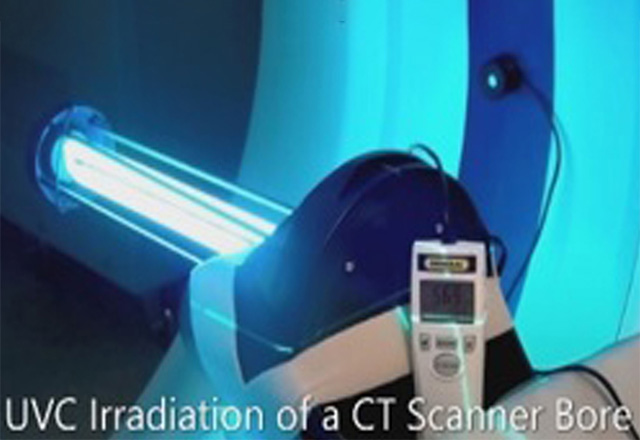 Credit: Jeff Siewerdsen and Mahadevappa Mahesh
Credit: Jeff Siewerdsen and Mahadevappa Mahesh
Could Ultraviolet Light Disinfect CT Scanners?
Johns Hopkins biomedical engineer Jeff Siewerdsen and medical physicist Mahadevappa Mahesh are investigating the use of UV low-cal to disinfect the inner bore of CT scanning machines, a cramped infinite that is exposed to exhaled particles from patients and is difficult to reach past manually wiping it down.
Siewerdsen and Mahesh are studying UVC rays, which tin can eliminate a high proportion of SARS-CoV-two virus from hard surfaces, not the typical UVA rays, which tend to cause peel cancer and other problems.
If the UVC process for CT scanners proves useful, the process could be used in addition to the manual wipe down of CT scanners, amend the rubber of personnel and patients, and be applicable to many health intendance facilities effectually the world.
Note: Exposure to UVC light could harm health. UVC lamps should not be used without proper training and rubber precautions.
Read the total story in our Newsroom
Date Posted: May 4, 2021 | Disclaimer
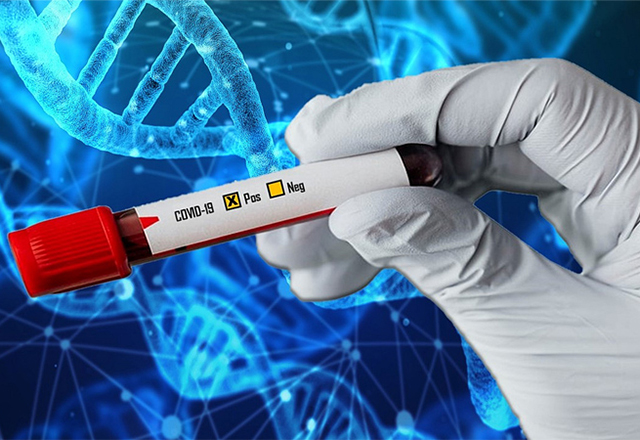 Credit: Graphic created by One thousand.E. Newman, Johns Hopkins Medicine, using public domain images.
Credit: Graphic created by One thousand.E. Newman, Johns Hopkins Medicine, using public domain images.
Immunology of COVID-19 to be Studied at New Center
The Johns Hopkins University School of Medicine and the Johns Hopkins Bloomberg School of Public Health will receive more than $2 million per year in a five-year grant from the National Institutes of Health's National Cancer Institute to class a center for studying the immune response to SARS-CoV-2, the virus that causes COVID-19.
The goal of the Johns Hopkins Excellence in Pathogenesis and Immunity Center for SARS-CoV-ii (JH-EPICS) is to provide a deeper understanding of how the virus impacts the immune arrangement in order to facilitate development of effective treatments and vaccines against information technology.
Read more about the heart in our Newsroom
Date Posted: April 29, 2021 | Disclaimer
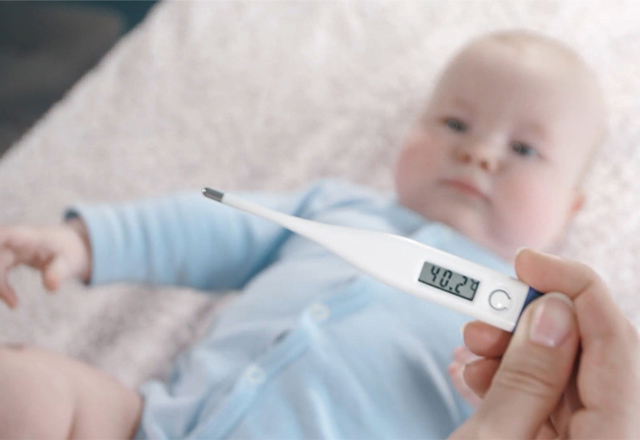
Youngest COVID-nineteen Patients Almost Likely to Avoid Severe Disease, Recover With Intendance
A Johns Hopkins Medicine report found that if infants less than three-months-old get COVID-19, they experience mild to moderate cases and usually recover with supportive intendance.
These tiny patients accept nonetheless-developing immune systems and frequently come in close contact with their caretakers, making them potentially more vulnerable to infection with the virus compared with older infants and other immature children.
Of 63 patients evaluated for the study, 13 (21%) were admitted to an intensive care unit and 2 (iii%) required invasive mechanical ventilation. No deaths were reported.
Read more about the research in our Newsroom
Date Posted: April 27, 2021 | Disclaimer
 April Pruski, Yard.D.
April Pruski, Yard.D.
Like Polio, COVID-nineteen Underscores the Importance of Rehab Medicine
When historians reflect on the last polio outbreak in the The states, they typically focus on Jonas Salk's 1955 vaccine that led to nigh eradication of the crippling disease.
Simply Johns Hopkins rehabilitation physician April Pruski says we also learned an important lesson from the thousands of patients who contracted polio in the 20th century: the importance of rehabilitation.
Pruski says 2020's COVID-19 pandemic has shone a similar lite on the field of rehabilitation medicine. The first weeks and months of COVID-19 treatment at The Johns Hopkins Infirmary brought hundreds of patients with a sudden demand for extensive rehabilitation services.
Patients in post-acute intendance for COVID-19 can have physical, mental and even cognitive impairments. According to a journal commodity published in the September 2020 upshot of the Archives of Physical Medicine and Rehabilitation and co-authored past Pruski and her division colleagues, nearly 900 patients with COVID-19 were admitted to The Johns Hopkins Infirmary between March 12 to July 22, many of whom were transferred from other hospitals when their illnesses worsened. Pruski estimates that from 60% to 70% of those patients required care from the Concrete Medicine and Rehabilitation Department — the largest such surge the section has ever experienced.
Read more near physical medicine and rehabilitation and COVID-nineteen in Clinical Connections
Engagement Posted: Feb 12, 2021 | Disclaimer
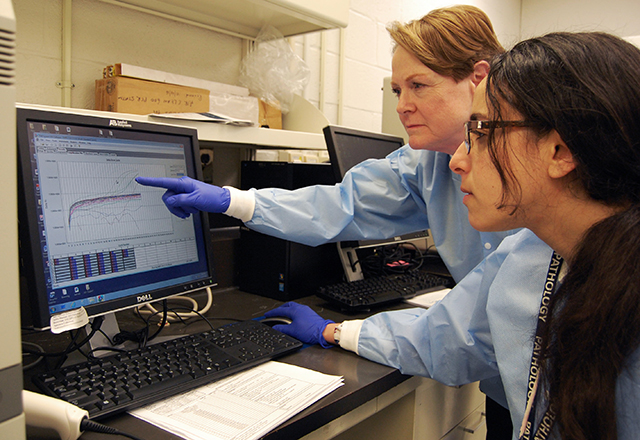 Drs. Karen Carroll (left) and Heba Mostafa (right).
Drs. Karen Carroll (left) and Heba Mostafa (right).
Does Prolonged COVID-nineteen Detection Identify People Who Are Infectious Long Term?
A team led past researchers at Johns Hopkins Medicine and the Johns Hopkins Bloomberg School of Public Health gained significant insight into when detection of SARS-CoV2, the virus that causes COVID-nineteen, may indicate when a person is contagious.
The researchers evaluated the results of repeated polymerase chain reaction (PCR) diagnostic tests for SARS-CoV-ii genetic fabric (RNA) in 29,686 nasopharyngeal swabs. The PCR exam is very specific and detects viral RNA. The number of times it takes to get a positive signal is chosen the wheel threshold (Ct), with a depression Ct score indicating a large amount of SARS-CoV-2 RNA and a high one but the opposite.
"Nosotros likewise placed a portion of the specimens in cell cultures to come across whether or not live virus particles would grow," says Heba Mostafa, M.B.B.Ch., Ph.D., assistant professor of pathology at the Johns Hopkins University Schoolhouse of Medicine. "In that way, we could compare the Ct values with actual virus recovery in the lab to see when detected virus also was infectious virus."
"RNA detection in repeated tests may indicate someone who continues to be infectious with persistent symptoms," Mostafa says. "However, additional studies are needed to truly decide if Ct values and cell cultures can exist used together to make clinical decisions, develop diagnostic strategies and identify those near probable to spread SARS-CoV-2."
"Defining the window of time in which a COVID-19 patient can transmit the virus can help drive more constructive isolation practices," adds Andrew Pekosz, Ph.D., professor of microbiology and immunology at the Johns Hopkins Bloomberg School of Public Wellness.
Read more well-nigh the research in our Newsroom
Date Posted: Feb 8, 2021 | Disclaimer
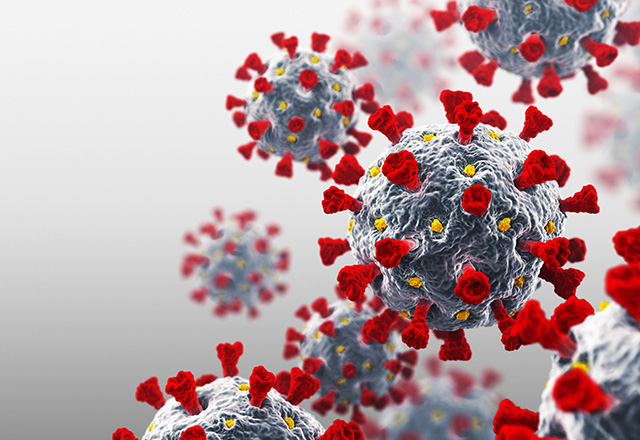
Lessons From Crumbling Affliction May Cake Coronavirus Infection
An enzyme linked to a premature aging disease called progeria may also defend against viruses, including SARS-CoV-2, which causes COVID-xix.
The enzyme, called membrane-associated zinc metalloprotease ZMPSTE24, was discovered by the laboratory of Susan Michaelis. She has spent the last several decades studying the enzyme and its event on a protein called lamin A, which is disquisitional to maintaining the structure of the nucleus, a cell's control center.
Mutations in the genes that encode either ZMPSTE24 or lamin A cause progeria, the disease that accelerates aging from nascence and is ofttimes fatal by the time children are in their teens.
Other researchers accept shown that ZMPSTE24 also has a office in the immune system response to many viruses. Michaelis' team is now studying whether ZMPSTE24 can block SARS-CoV-2 from entering a host jail cell and how the enzyme manages to do this.
The findings, says Michaelis, may reveal a style to provide cells with a better defense against SARS-CoV-2.
Read about the research in our Newsroom
Engagement Posted: December 1, 2020 | Disclaimer
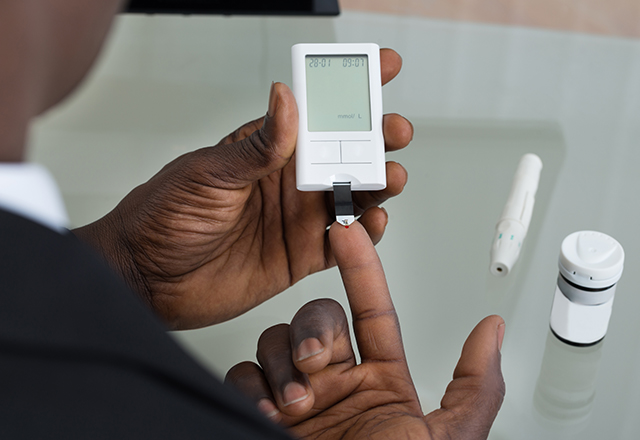
Scientists Convert a Common Device to a COVID-19 Detector
A trio of Johns Hopkins scientists — a pharmacologist, a biomedical engineer and a biophysicist — are pooling their knowledge to design a device that tin detect whether a person has antibodies linked to SARS-CoV-2, the virus that causes COVID-19. Antibodies are tiny proteins that the immune system produces to "recall" viral encounters and provide immunity to time to come infections.
To develop an antibody detector that can be deployed apace and inexpensively across the globe, the researchers got their inspiration from a test that is already used by millions of people: a glucose monitor.
People with diabetes use glucose monitors to measure their claret saccharide levels by taking a tiny prick of claret from their finger and placing it on a paper test strip that is inserted into the monitor. This same blazon of tool could exist reconfigured to find glucose in a series of chemic reactions that occur when antibodies are detected in the blood, say the researchers, led by Netz Arroyo, Ph.D., banana professor of pharmacology and molecular sciences, Jamie Spangler, Ph.D., banana professor of biomedical engeineering, and Taekjip Ha, Ph.D., Bloomberg Distinguished Professor of Biophysics and Biophysical Chemical science, Biophysics and Biomedical Engineering.
Showtime, the researchers developed a test strip that contains the "spike" protein from the surface of the SARS-CoV-2 virus. They add a drop of blood from a patient, and the spike proteins on the exam strip bind with COVID-xix-related antibodies nowadays in the claret. Then, the researchers dip the strip into a tube with an enzyme that binds to the COVID-xix antibodies.
Later washing off the backlog enzyme, the scientists insert the strip into a solution containing a molecule that is transformed past the enzyme into glucose. Finally, a commercial glucose monitor reads the corporeality of glucose present on the test strip, which is a surrogate for COVID-19 antibodies nowadays in the patient's blood sample.
The researchers are continuing to refine and test the patent-pending technology.
Read more than about the research in The Baltimore Sun
Date Posted: November 27, 2020 | Disclaimer
 Colorized scanning electron micrograph of a cell (purple) heavily infected with SARS-CoV-two virus particles (yellow). A recent study by Johns Hopkins Medicine shows that blocking a specific protein in a biological pathway may preclude SARS-CoV-two infection and go along the virus from misdirecting the immune system against healthy cells and organs. Credit: National Institute of Allergy and Infectious Diseases, National Institutes of Health
Colorized scanning electron micrograph of a cell (purple) heavily infected with SARS-CoV-two virus particles (yellow). A recent study by Johns Hopkins Medicine shows that blocking a specific protein in a biological pathway may preclude SARS-CoV-two infection and go along the virus from misdirecting the immune system against healthy cells and organs. Credit: National Institute of Allergy and Infectious Diseases, National Institutes of Health
Blocking Immune System Pathway May Stop COVID-nineteen Infection, Prevent Severe Organ Damage
A recent report by Johns Hopkins Medicine shows that blocking a specific protein in a biological pathway may forestall infection with SARS-CoV-two, the virus that causes COVID-19, and keep the virus from misdirecting the allowed system against healthy cells and organs.
Based on their findings, the researchers believe that inhibiting the protein, known as gene D, also will curtail the potentially mortiferous inflammatory reactions that many patients have to the virus.
To infect cells, proteins on the surface of the SARS-CoV-2 virus grab hold of heparan sulfate, a large, complex saccharide molecule found on the surface of cells in the lungs, blood vessels and polish muscle making upwards most organs. Then, the virus uses another cell-surface component, the protein known every bit angiotensin-converting enzyme 2 (ACE2), as its doorway into the attacked cell.
The Johns Hopkins Medicine team discovered that when SARS-CoV-2 ties upward heparan sulfate, information technology prevents factor H from using the saccharide molecule to bind with cells. Cistron H's normal function is to regulate the chemic signals that trigger inflammation and keep the immune system from harming healthy cells. Without this protection, cells in the lungs, centre, kidneys and other organs tin be destroyed by the defence mechanism nature intended to safeguard them.
Robert Brodsky, M.D., manager of the hematology partition at the Johns Hopkins Academy School of Medicine, led the enquiry team. They found that by blocking some other protein, known as gene D, which works immediately upstream in the pathway from gene H, they were able to terminate the destructive chain of events triggered by SARS-CoV-2.
Read more than most the research in our Newsroom
Appointment Posted: November 25, 2020 | Disclaimer
Play Video:
Robots Joining the Front end Lines to Boxing COVID-nineteen
Johns Hopkins is testing a small-scale robot attached to a touchscreen ventilator and then that no one has to wear protective equipment and risk infection entering an intensive care unit room.
Robotic Organization Remotely Controls Ventilators in COVID-xix Patient Rooms
A new robotic organisation allows medical staff to remotely operate ventilators and other bedside machines from outside intensive intendance rooms of patients with infectious diseases.
The system, developed by a team of Johns Hopkins University and Medicine researchers, is still being tested, but initial trials accept demonstrated how it could be deployed to help hospitals preserve protective gear, limit staff exposure to COVID-19 and provide more time for medical work.
"Two of the toughest challenges we faced at the peak of COVID-nineteen were staffing and PPE (personal protective equipment)," says Sajid H. Manzoor, director of adult respiratory therapy at The Johns Hopkins Hospital.
The pandemic spurred a massive surge of highly infectious, intensive care patients requiring ventilators, infusion pumps and other support equipment. Treating them requires hospital personnel to change protective gear every time they enter rooms, even for minor adjustments to machines.
"This remote-control system volition exist a force multiplier for our frontline clinicians," said Jonathan Cope, a respiratory therapist who assisted with the project. "Beingness able to salvage fourth dimension to deliver more than care to more patients volition pay huge dividends when we face massive scenarios such equally pandemics."
Academy of Maryland computer science graduate educatee Misha Khrenov – working under computer science professor Axel Krieger, who joined The Johns Hopkins Academy in July – and Johns Hopkins enquiry scientist Balázs P. Vágvölgyi built the working epitome.
The robotic device is affixed to the ventilator's bear upon screen with a horizontal bar secured across the height border. The bar serves equally a stationary track for the dorsum-and-forth movement of two continued vertical bars that extend the full peak of the screen. As the vertical bars sweep beyond the screen, a stylus they carry moves up and downward according to its commands, similar to how an Etch A Sketch moves its cartoon tool along an X-Y axis. A photographic camera connected to the top bar sends an image of the screen to the operator'southward tablet outside the room.
"Whether it'southward for Covid or the next pandemic, there is always going to be a need for this," he said. "Information technology will definitely end up in the ICU surroundings in the coming years."
Engagement Posted: September 10, 2020 | Disclaimer
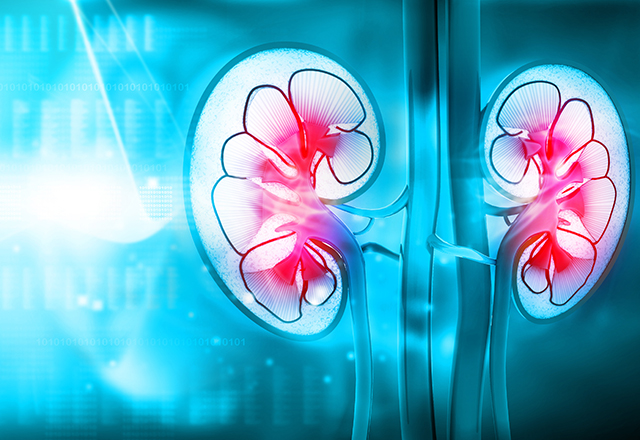
Dialysis Patients at Greater Risk of Coronavirus Infection
It'south widely known that the SARS-CoV-2 virus, which causes COVID-19, can spread chop-chop among residents in nursing homes and other long-term care facilities, leading to high numbers of cases and deaths in a very vulnerable population. According to a new report led by researchers at Johns Hopkins Medicine, residents receiving hemodialysis for chronic kidney affliction may exist at fifty-fifty greater risk for infection from the virus.
The researchers investigated an outbreak of COVID-nineteen that occurred in April 2020 in a 200-bed Maryland nursing home with an independently operated, on-site hemodialysis heart. The researchers reported that 15 of the 32 residents (47%) on dialysis tested positive while only 22 of the other 138 residents (xvi%) did.
"Based on our results, nosotros believe that nursing abode residents undergoing dialysis are more likely than others in a facility to have repeated and prolonged exposures to the SARS-CoV-ii virus, and therefore may be at greater risk of infection and subsequent COVID-nineteen," says Benjamin Bigelow, a fourth-twelvemonth medical student at the Johns Hopkins Academy School of Medicine and the study'due south lead author.
"Our written report suggests that to prevent COVID-19 outbreaks, nursing homes and dialysis centers need to maintain clear and constant communication to improve infection prevention practices throughout the process of transporting residents to dialysis and during the dialysis itself," says Morgan Katz, Chiliad.D., M.H.Southward., assistant professor of medicine at the Johns Hopkins University School of Medicine and senior author of the written report. "Residents who undergo dialysis should be advisedly monitored, and testing prioritization must business relationship for whatever contact with dialysis staff who may have been exposed to SARS-CoV-2."
Read more about the written report in our Newsroom
Engagement Posted: September 4, 2020 | Disclaimer
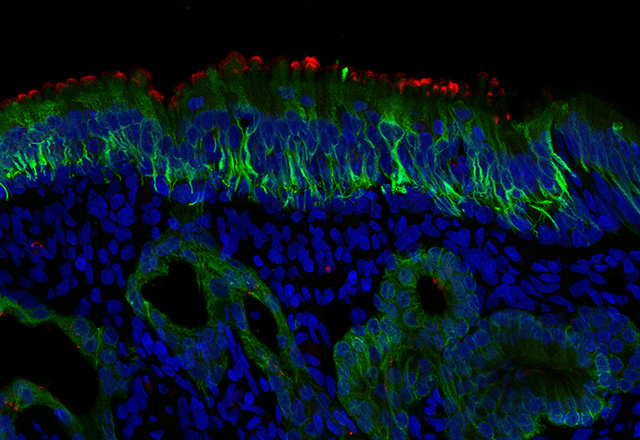 Red stain is ACE2. The green probe is staining CK18, which is found in supporting cells and mucus glands. Credit: Photo by Mengfei Chen
Red stain is ACE2. The green probe is staining CK18, which is found in supporting cells and mucus glands. Credit: Photo by Mengfei Chen
Study Adds to Evidence That Odor-Sensing Cells in the Olfactory organ Are the Key Entry Indicate for Coronavirus
Scientists at Johns Hopkins Medicine, experimenting with a minor number of human jail cell samples, study that the "hook" of cells used past SARS-CoV-2, the virus that causes COVID-nineteen, to latch onto and infect cells is up to 700 times more prevalent in the olfactory supporting cells lining the inside of the upper part of the nose than in the lining cells of the rest of the nose and windpipe that leads to the lungs. These supporting cells are necessary for the office and development of odor-sensing cells.
The findings, from a preliminary written report of cells lining both the nose and trachea, could accelerate the search for the all-time target for topical or local anti-viral drugs to treat COVID-19, and offers farther clues into why people with the virus sometimes lose their sense of smell.
"Loss of the sense of smell is associated with COVID-19, generally in the absence of other nasal symptoms, and our enquiry may advance the search for a definitive reason for how and why that happens, and where we might best direct some treatments," says Andrew Lane, Yard.D., professor of otolaryngology-head and neck surgery, and director of the Division of Rhinology and Skull Base Surgery at the Johns Hopkins University School of Medicine.
Scientists have known that SARS-CoV-2 latches on to a biological hook on the surface of many types of human cells, called an angiotensin-converting enzyme 2 receptor (ACE2). The receptor reels in essential molecules.
They found loftier levels of ACE2 among certain types of nasal cells where odor-sensing neurons are constitute. These cells had a 200-fold to 700-fold increment in ACE 2 proteins compared with other samples from the olfactory organ and trachea.
Because the cells with high levels of ACE2 are associated with odor sensing, the researchers suggest that infection of these cells may be the reason some people with COVID-19 experience loss of smell.
The cells lining the nose may prove to be a key entry point for SARS-CoV-2, and Lane says there may exist ways to target those particular cells with topical anti-viral drugs or other therapies directly to that area.
Read more nigh the study in our Newsroom
Date Posted: September 1, 2020 | Disclaimer
Play Video:
How Coronaviruses Work
Coronaviruses are tiny. They're and then small that scientists need a special microscope to spot them. This video animation is an artist's rendering of how coronaviruses invade, replicate and gather a new army of viruses inside a host cell.
Within a Coronavirus-Infected Cell
To build a amend vaccine, end a virus from replicating or attaching to host cells, aid the allowed system fight the virus, or any type of remedy to the electric current pandemic of COVID-19, scientists need to understand how coronaviruses piece of work. These scientists focus on the so-called "basic" or "central" biology of viruses.
For case, coronaviruses are known to invade and replicate within host cells, and newly made viruses escape through the host cell'due south outer membrane. But instead of going straight to the cell membrane to get fix to exist shipped out of the host jail cell, coronaviruses cease at a pancake-similar structure in the jail cell called the Golgi complex, a kind of postal service role that sorts and processes proteins and spits them out of the prison cell later on enclosing the proteins in a compartment called a vesicle.
Johns Hopkins scientists have been working to decide why coronaviruses brand this extra end in their replication and escape process. I reason, they establish, is that coronaviruses neutralize the acidity of the Golgi complex, potentially paving a better path to assistance the viruses, with their spiky halo, escape cells.
Date Posted: August iv, 2020 | Disclaimer
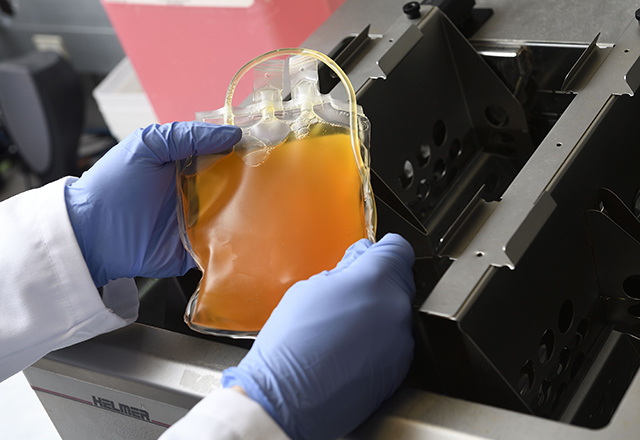
Section of Defense Funds $35 Million COVID-19 Blood Plasma Trials Led by Johns Hopkins
Johns Hopkins researchers have received $35 million in funding from the U.S. Department of Defense to test the effectiveness of a ambulatory blood plasma outpatient treatment. The treatment is a transfusion of a blood product from COVID-xix survivors that contains antibodies that may help the patient'south allowed organization fight the virus.
Two clinical trials totaling i,100 people volition exist conducted at over 20 outpatient centers in medical centers across the U.Due south., including the Navajo Nation, and will aid researchers determine whether ambulatory blood plasma therapy tin effectively exist used to treat people in the early stage of COVID-19 illness or foreclose the infection in those at high gamble of exposure to the virus at their home or jobs.
The prevention trial volition include 500 people who accept been exposed to COVID-19 in their home or at work as wellness intendance providers. A second trial will recruit 600 participants who have early on COVID-19 disease, meaning they are within eight days of their first symptoms but are not sick enough to be in a hospital. All participants will be over age 18. The researchers aim to complete recruitment of participants to the trials in early fall 2020.
Convalescent blood plasma therapy involves transfusing a portion of blood chosen plasma from people who have recovered from the virus. When separated from cerise and white blood cells and platelets in the claret, plasma is the xanthous-tinged liquid that includes proteins called antibodies, which glom on to foreign substances such as viruses and either mark them for devastation by the immune arrangement or disrupt a virus' ability to multiply and grow.
There is very piddling clinical information proving the effectiveness of using the therapy in outpatient clinics, according to the researchers. Currently, only hospitalized patients accept access to whatever blazon of therapy for COVID-19.
Leaders of the trials include Arturo Casadevall, Grand.D., Ph.D., Bloomberg Distinguished Professor who holds articulation appointments in the Johns Hopkins Bloomberg Schoolhouse of Public Wellness and the Johns Hopkins University School of Medicine, Shmuel Shoham, G.D., associate professor of medicine at the Johns Hopkins Academy School of Medicine, David Sullivan, M.D., professor of molecular microbiology and immunology at the Johns Hopkins Bloomberg School of Public Health, and Daniel Hanley, M.D., director for multisite clinical trials in the Johns Hopkins Institute for Clinical and Translational Inquiry at the Johns Hopkins University School of Medicine.
Read more about the new studies in our Newsroom
Engagement Posted: July 30, 2020 | Disclaimer
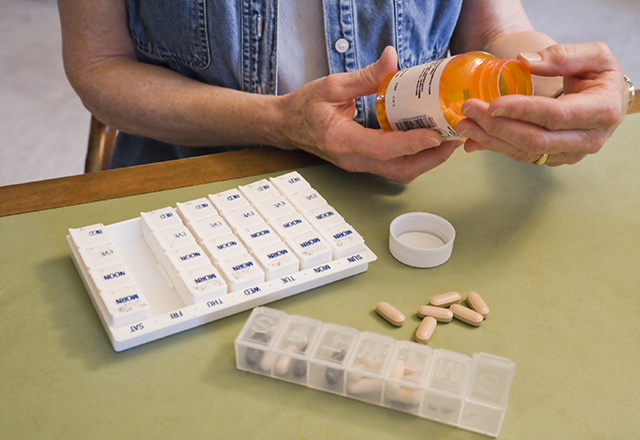
Practise Medications that Reduce Immune Response Raise Risk for COVID Complications?
Gastroenterologist Brindusa Truta and her colleagues are surveying three,000 patients with inflammatory bowel disease (IBD), which is often treated with medications that suppress the immune system and reduce inflammation, to determine whether those with IBD are at higher risk of complications from COVID-nineteen illness.
"In that location is absolutely no information regarding IBD and the virus," Truta says. "Therefore, we decided to get ahead and interview our patients from fourth dimension to fourth dimension near their infection status, their medications and other adventure factors."
It'south non even so clear how being on immunosuppressive medications can alter the variables and risk factors for contracting the pandemic coronavirus compared with typical adults non taking the medications, says Truta. IBD clinic staff at Johns Hopkins will exist interviewing patients during telemedicine checkups or through questionnaires virtually their daily habits and activities, employment status, transportation and living arrangements. If patients have no symptoms of COVID-nineteen at the time of the interview, clinic staff members follow up with them afterwards. If they practice become infected, they're asked to call the clinic to let them know, and to potentially have their medications adjusted.
"Every footstep in unlocking the economy is going to come with more than interactions among people and more exposure," she says. "Some of our patients will return to work, and then nosotros wanted to deploy our questionnaire at unlike points of fourth dimension trying to capture what happens."
So far, patients have been very willing to share their information. Some who did develop symptoms called the dispensary to say what they were doing and how they think they became infected. Based on the evidence gathered so far, says Truta, the virus does non currently announced to bear upon this population any worse than the general population. Most patients infected and on immunosuppression seem to recover without going to the infirmary, with some variations based on age and whether a person has 2 or more than chronic health conditions.
"You would expect that patients who are on medications to lower their immune response, as many of our IBD patients are, would accept a higher gamble of getting infected [with coronavirus] and a poorer outcome, but based on our data then far, we are not seeing that," Truta says. "They don't have better outcomes than the general population, merely I call up that they are improve than nosotros expected."
Read more than about the enquiry in Inside Tract
Date Posted: July 23, 2020 | Disclaimer

Keeping Pediatric ICUs Continued During COVID-19
Based on information gathered during the COVID-nineteen pandemic, researchers at Johns Hopkins Medicine and the Connecticut Children's Medical Center found that social media, primarily Twitter, is an effective way to keep intendance teams at pediatric intensive care units (PICUs) around the world connected and informed during a global medical crisis.
Among the massive volume of tweets with a COVID-19 hashtag posted during February to May were ones that included a 2nd hashtag, #PedsICU — a social media designation created long earlier the pandemic to foster international collaboration, apace disseminate information and keep the lines of professional person communication flowing amidst members of the pediatric critical care community.
"We wanted to make up one's mind if leveraging social media, specifically Twitter, was a solid strategy for keeping PICUs across the globe connected and informed on the well-nigh electric current information during a pandemic," says Sapna Kudchadkar, One thousand.D., Ph.D., associate professor of anesthesiology and critical care medicine.
To deport their study, Kudchadkar and co-investigator Christopher Carroll, M.D., Chiliad.S., research director of pediatric critical care at the Connecticut Children'south Medical Center, collected data on all tweets posted worldwide from Feb. 1 to May ii that contained the hashtag #PedsICU, along with those containing both #PedsICU and a recognizable COVID-nineteen hashtag, such equally #COVID19.
There was a sharp ascension in tweets with both hashtags around mid-March, which coincided with the World Wellness Organization raising COVID-19 to pandemic status. Since then, more than two-thirds of #PedsICU tweets were about the disease. About a third of the tweeters were physicians, simply the researchers note there were also tweets from other PICU team members, including nurses, nurse practitioners, respiratory therapists and pharmacists.
The most popular tweets during the study period, the researchers say, were links to medical literature, reviews, educational videos and other open up-access resources.
"Our study demonstrates that during a pandemic such as COVID-nineteen, targeted use of #PedsICU combined with a specific affliction-related hashtag significantly helps combat misinformation, quickly spreads useful information and news, and optimizes the accomplish of pediatric critical care stakeholders to others around the earth," says Kudchadkar.
Read more in our Newsroom virtually the study
Date Posted: July 20, 2020 | Disclaimer
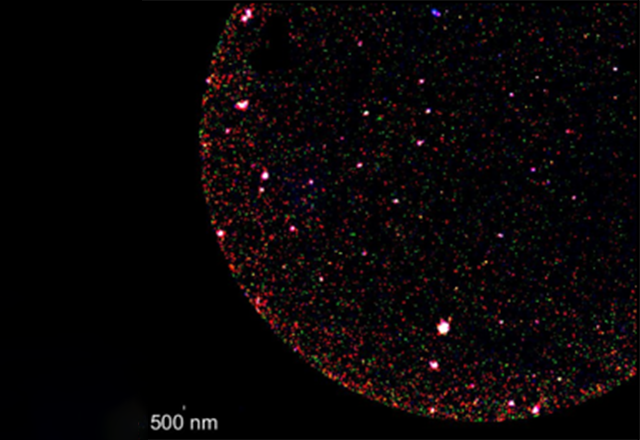 Fluorescence prototype of neuron-derived extracellular vesicles. Credit: Kenneth Witwer, Ph.D.
Fluorescence prototype of neuron-derived extracellular vesicles. Credit: Kenneth Witwer, Ph.D.
Prison cell's 'Postal Organization' Studied to Diagnose, Monitor and Treat COVID-19
Tiny, spherical pods bladder from 1 cell to another through the crowded infinite of other cells and fluids such every bit claret and mucus. These bundle-like pods are unassuming. They slip by other cells and complex tissues, intent on delivering their contents to the intended recipient.
Later on pinching off from the cell, these packets carry specific content from the cells they came from, much similar a letter of the alphabet in the postal service.
These postal pockets that are ferried between cells are known by scientists equally extracellular vesicles. Since they behave contents from within a jail cell, scientists believe these packets can provide clues about pathogens or diseases that may be harboring within cells.
For decades, this valuable insight has led researchers to explore the possibilities extracellular vesicles might agree for disease diagnosis, monitoring and even treatment.
Johns Hopkins Medicine researcher Kenneth Witwer, Ph.D., has studied extracellular vesicles for much of his career and is the executive chair of science and meetings for the International Society for Extracellular Vesicles.
Witwer suggests that extracellular vesicles may be able to help researchers studying COVID-19 in three ways:
- Make a stronger vaccine for COVID-xix,
- Develop a style to repair lung impairment and autoimmune responses to COVID-19 and
- Monitor COVID-19 treatment effectiveness in patients.
Read about the COVID-xix fighting potential of extracellular vesicles
Appointment Posted: July half-dozen, 2020 | Disclaimer

Latinx Populations Have Higher Rates of Coronavirus
In a new analysis of SARS-CoV-2, the virus that causes COVID-nineteen, test results for nearly 38,000 people take shown a positivity rate among Latinx populations about three times higher than for whatever other racial and ethnic group. The findings, published June 18 in the Periodical of the American Medical Association (JAMA), adds to evidence of much higher COVID-19 infection rates among U.S. minorities, particularly in the Latinx community.
Out of 37,727 adults and children tested between March 11 and May 25 across five Johns Hopkins Wellness Arrangement hospitals, including emergency departments, and 30 outpatient clinics in the Baltimore-Washington area, 6,162 tests came dorsum positive. Of those tests, the positivity rate for Latinx was 42.6%, significantly higher than those who identified as Black (17.6%), other (17.2%) or white (8.8%).
Amongst those who tested positive, ii,212 were admitted to a Johns Hopkins Health Organisation infirmary. The report information show that Latinx patients were less likely to be admitted to the infirmary (29.1%), compared with Black (41.7%) and white (40.1%) patients.
Researchers Diego Martinez, Ph.D., assistant professor of emergency medicine, and Kathleen R. Page, M.D., associate professor of medicine and a study member, advise that crowded living conditions, lack of wellness insurance, fear of displacement and demand to work in weather condition more than probable to expose them to infection all contributed to the college rate of positive tests.
Read more details on the report
Date Posted: July 1, 2020 | Disclaimer
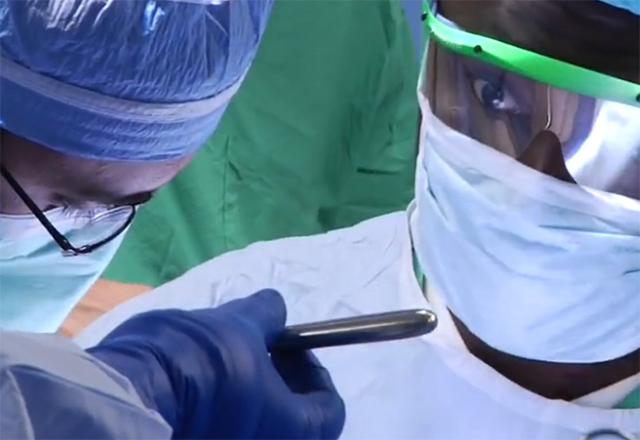
Elective Surgeries in the U.S. May be Backlogged Up to a Year Due to COVID-xix
A new study by Johns Hopkins researchers constitute that it may take between seven and xvi months for surgeons across the U.S. to complete the backlog of elective orthopaedic surgeries that have been suspended during the COVID-19 pandemic. Elective surgeries, not necessarily optional, are ones that tin be planned in accelerate. This accounts for more than a one thousand thousand surgeries in the U.S. for spinal fusion and articulatio genus and hip replacements.
The study was published online May 12 in The Journal of Bone and Joint Surgery.
Atomic number 82 author Amit Jain, M.D., chief of minimally invasive and outpatient spine surgery and associate professor of orthopaedic surgery and neurosurgery at the Johns Hopkins Academy School of Medicine, says that in fields such as orthopaedic surgery, where procedures are frequently performed in an inpatient setting, the ramp-upward may be slower than surgeries typically done in outpatient facilities. "We will keep calculation to the backlog as long equally nosotros are not operating at 100% capacity," states Jain.
Jain and his colleagues used the Agency for Healthcare Research and Quality National Inpatient Sample, a national database that contains hospital inpatient data, to model the number of current and forecasted spinal fusion and hip and knee replacement surgeries in the United States. The researchers found that, in an optimistic scenario where virtually elective surgeries are dorsum to total chapters in June, it would take approximately 7 months to get through the backlog. Delays to the ramp-upwards to total capacity could extend the backlog to sixteen months.
To assist ease the backlog, Jain proposes several strategies to increase surgical throughput, including more employ of telemedicine. At Johns Hopkins, telemedicine apply has skyrocketed. He besides suggests making more than timeslots available in operating rooms for orthopaedic surgeries, increasing intendance coordination resources and shifting care to ambulatory surgery centers as much every bit possible.
Along these lines, researchers in the Johns Hopkins dermatology department are working with the Johns Hopkins Carey School of Business to written report the impact of deferred procedures on health care operations and finances, the effects on illness and patient-reported outcomes and how to solve the problems that ensue.
Date Posted: June 19, 2020 | Disclaimer
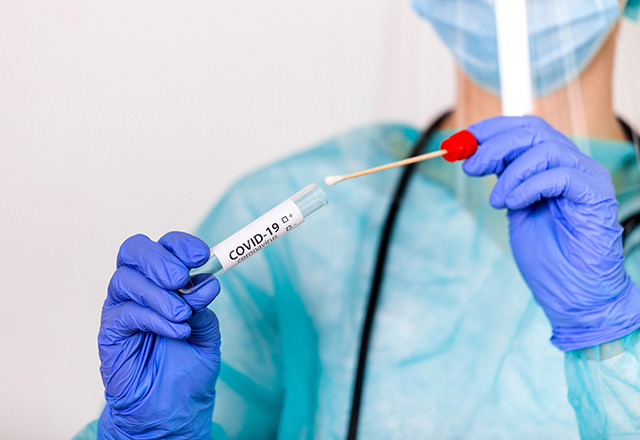
Beware of Faux Negatives in Diagnostic Testing of COVID-19
One of the well-nigh common ways to diagnose COVID-19 is the reverse transcriptase polymerase chain reaction examination (RT-PCR), which uses a sample from a person's nasal passages to detect particles from the SARS-CoV2 virus, which causes COVID-nineteen.
These tests have played a critical role in our nation's response to the pandemic. But, while they are of import, researchers at Johns Hopkins accept found that the chance of a simulated negative outcome — when the virus is non detected in a person who actually is, or recently has been, infected — is greater than ane in five and, at times, far college. The researchers caution that the test'southward ability to notice the virus may not always yield accurate results, and timing of the test seems to thing greatly in the accurateness.
In the study on the findings published May 13 in the journal Annals of Internal Medicine, the researchers found that the probability of a fake negative consequence decreases from 100% on Day ane, meaning highly likely to be a false negative, to 67% on Day four, meaning withal very likely to have a imitation negative event. The simulated negative charge per unit decreased to xx% on 24-hour interval 8 (three days afterward a person begins experiencing symptoms). They likewise found that on the twenty-four hours a person started experiencing actual symptoms of disease, the average imitation negative rate was 38%. In addition, the fake negative rate began to increase again from 21% on 24-hour interval 9 to 66% on Day 21.
The study, which analyzed seven previously published studies on RT-PCR operation, adds to evidence that caution should exist used in the interpretation of negative examination results, particularly for individuals probable to have been exposed or who have symptoms consequent with COVID-19.
Date Posted: June 16, 2020 | Disclaimer
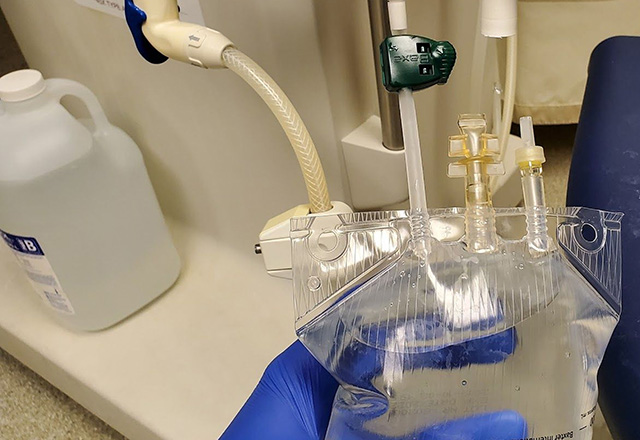
New Method to Make Kidney Dialysis Fluid for Patients with COVID-nineteen
The ongoing COVID-19 pandemic has severely impacted the manufacturing and supply chains for many products. Just while shortages of toilet paper, disinfectant cleaners and hand sanitizer become most of the news coverage, the diminishing reserve of i particular — kidney dialysis fluid, also known as dialysate — presents a grave threat to the lives of people with acute kidney injury (AKI), including the approximately 3% to ix% of COVID-19 patients who develop the disorder.
Without the special type of 24-hour, slowly administered dialysis — called continuous veno-venous hemodialysis, or CVVHD — that is given to AKI patients in an intensive care unit, damaged kidneys cannot remove wastes and excess fluids from the blood as they normally do. Unfortunately, the COVID-19 pandemic has severely tapped dialysate supplies across the nation.
When two New York-based hospitals recently contacted Derek Fine, Chiliad.D., clinical director of nephrology at the Johns Hopkins University School of Medicine, to seek spare dialysate to help meet their need for some three,000 liters per day (for all of their AKI patients in ICUs, both with and without COVID-19), he and Chirag Parikh, M.D., Ph.D., M.B.B.Southward., director of the medical school's Partition of Nephrology, came up with a better idea to remedy the trouble.
Their solution was to supercede the dwindling stocks of pre-mixed, commercially produced dialysate required for short-term ICU kidney dialysis machines with a suitable substitute manufactured by conventional hemodialysis devices and designed for long-term treatment.
The latter creates its own dialysate in real time from ultrapure water and concentrated chemical solutions.
Fine, Parikh and colleagues from their division studied the workings of a conventional dialysis auto, learned how it manufactures dialysate and so adjusted the system to override alarms, which if triggered would automatically close downward dialysate production. However, i major obstacle remained: how to get the newly minted dialysate into bags.
No problem, thanks to students from the Johns Hopkins Academy Department of Biomedical Engineering. In merely 12 hours, they designed a connector and used a 3D printer to return the plastic slice.
"When we tried it out, we were successfully able to capture the dialysate, and that was the eureka moment," Parikh says.
The U.S. Nutrient and Drug Administration has already provided guidelines for the method, calling for all dialysate produced to exist tested intermittently for bacteria and used within 12 hours from its origin.
Read about how our team has shared details on the new method
Appointment Posted: May 29, 2020 | Disclaimer
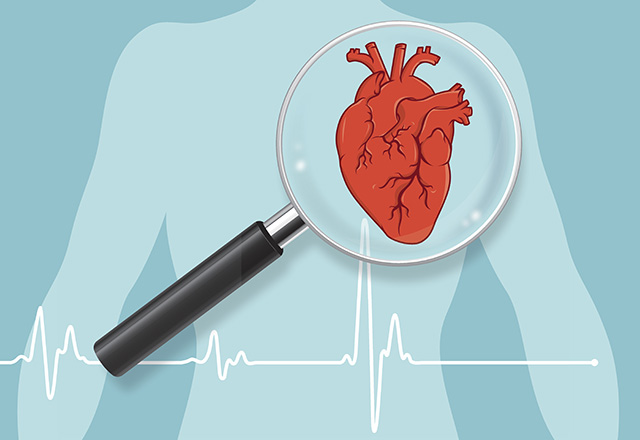
Auto Learning May Predict Heart Issues in People with COVID-nineteen
With a $195,000 grant from the National Science Foundation, Johns Hopkins researchers will utilize machine learning to study how to predict heart problems, such as heart failure, sustained abnormal heartbeats, centre attacks, cardiogenic stupor and death, in people with COVID-nineteen.
Middle problems are a mutual occurrence in COVID-19 patients, the researchers say, nonetheless, there is currently no predictive tool to specifically predict such problems in patients.
"This project will provide clinicians early alarm signs and ensure that resource are allocated to patients with the greatest need," says bioengineering proficient Natalia Trayanova.
Collecting Information and Testing
In the starting time phase of the one-year project, researchers volition collect data on middle tests, vital signs and imaging information from more than than 300 COVID-19 patients. This data volition be used to train a computer algorithm.
Then, the researchers will test the algorithm with data from COVID-19 patients with heart injury. The hope is to create a predictive take chances score that can decide, up to 24 hours ahead of fourth dimension, which patients are at take a chance of developing centre issues.
"Equally a clinician, major noesis gaps be in the ideal approach for new eye problems that are common and may be life-threatening. These patients have varying clinical presentations and a very unpredictable hospital grade," says cardiologist Allison M. Hays.
Making the Tool Widely Available
This project will shed more low-cal on how COVID-19-related heart injury could result in heart dysfunction and sudden cardiac death, which is critical in the fight against COVID-19. The projection will also help clinicians determine which biomarkers are most predictive of the potential for impairment to the patient.
Once the inquiry team creates and tests their algorithm, they will make it widely available to any interested health intendance institution to implement.
Read virtually how Johns Hopkins researchers are planning their studies
Date Posted: May 26, 2020 | Disclaimer
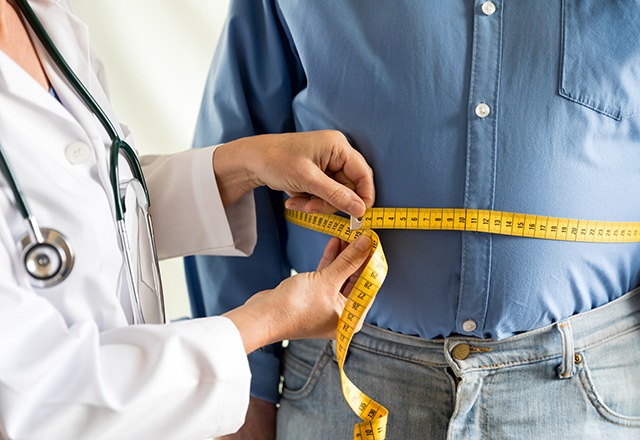
Obesity Linked to Severity of COVID-19 Infection in Younger Adults
As the COVID-xix pandemic was initially spreading, data from China and Italy suggested that merely about fifteen% of people under the age of fifty were being hospitalized. However, when the disease reached the The states, physicians anecdotally noted what seemed similar an uptick in the number of younger patients with COVID-19 serious enough to require intensive intendance.
Risk Factors for Severe COVID-19 Illness
Although preexisting weather such as center disease, diabetes or high claret pressure level have been linked to greater susceptibility to the virus, obesity wasn't on the radar every bit a chance factor early on in the coronavirus outbreak. That's considering only nigh 6% of Chinese people and xx% of Italians are obese. The United states of america, on the other hand, has a 40% rate of obesity in adults, making researchers wonder if this might cistron into the younger population's showing up with severe affliction.
Obesity and COVID-19
In a correspondence published on April thirty, 2020, in The Lancet, Johns Hopkins researchers examined the link between age and obesity of American patients with COVID-19 hospitalized in intensive care units (ICUs).
- Seventy-five percent of the patients had a body mass index (BMI) of 26 or greater, indicating the person equally overweight.
- 25% had a BMI college than 35, designating the person as morbidly obese.
In general, they found that those patients in the ICU that were younger had higher BMIs, suggesting that younger Americans with obesity are likely at greater risk from COVID-xix. The researchers say that immature people should pay attention to physical distancing and stay vigilant about when to seek medical treatment in the early stages of their disease to help reduce the risks.
Listen to scientist David Kass discuss these findings
Appointment Posted: May 22, 2020 | Disclaimer
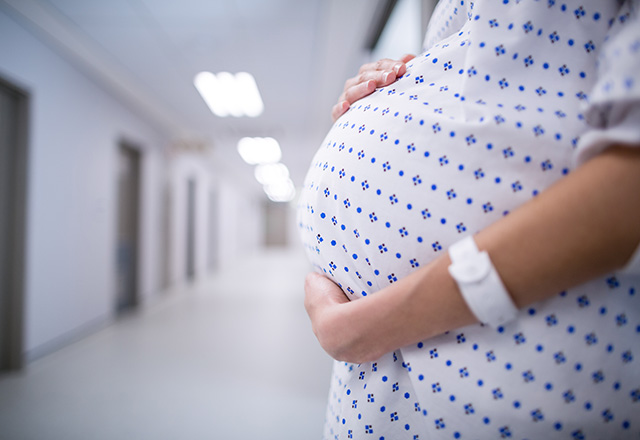
A Potential Link Between COVID-19 and Mental Illness
During the COVID-19 pandemic, most medical researchers have focused their studies on meliorate understanding the direct furnishings of the disease in guild to develop treatments and hopefully in the virtually future, a cure. However, two Johns Hopkins pediatric neurovirologists, Emily Severance, Ph.D., and Robert Yolken, M.D., are planning a report that will look for show of a possible secondary, long-term affect of COVID-nineteen: greater susceptibility to serious psychiatric illnesses such every bit schizophrenia.
Researchers have long suspected that prenatal (before birth) and perinatal (during and immediately after childbirth) exposure to respiratory viruses — including coronaviruses such as the one backside the current outbreak — may increase a person'southward chances of later developing a psychiatric disorder. In a 2011 study, Severance and Yolken showed that more than xc% of adults diagnosed with psychoses had high levels of antibodies to one or more of four coronaviruses mutual at that time.
Severance and Yolken now plan to await for a similar immunological link betwixt psychiatric disorders and SARS-CoV-ii, the virus that causes COVID-19.
Read the 2011 research paper by Severance and Yolken
Date Posted: May 14, 2020 | Disclaimer
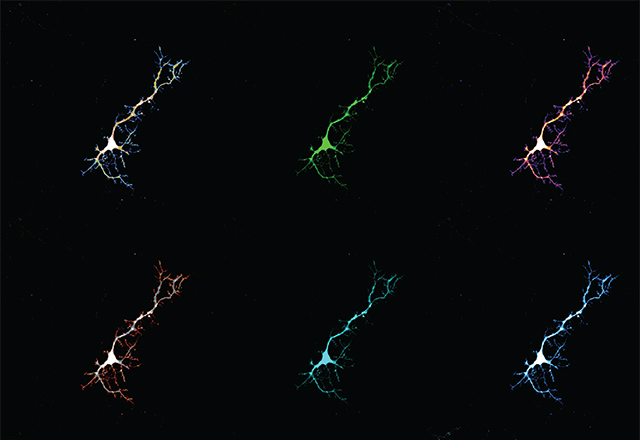 Image credit: Chirag Vasavda.
Image credit: Chirag Vasavda.
Does COVID-xix Touch on the Brain?
Equally COVID-19 spreads around the globe, the disease has a severe impact on the lungs and may, unexpectedly, touch on other parts of the body as well. One area of detail concern among researchers is the virus's potential impact on the encephalon.
Among the first symptoms of COVID-19 is the loss of odour and taste, and there are reports of people in recovery struggling with cognitive impairment or stroke. Co-ordinate to researchers, these symptoms could be caused past neurons degenerating or impairment to blood vessels that feed the encephalon.
"We need to get an agreement of how brain cells are affected by COVID-19, which cells are affected and how we can boring the harm," says Valina Dawson, Ph.D., manager of the neuroregeneration and stem prison cell programs at Johns Hopkins' Establish for Jail cell Technology.
Prison cell Types Affected past Coronavirus
Dawson plans to report cells in the nervous organisation that may be susceptible to impairment from the virus. A Johns Hopkins team will start with the basic question of which prison cell types are afflicted by the coronavirus, looking at neurons every bit well as supportive cells in the brain, called glia and microglia, and the encephalon's claret cells. And then, the squad aims to use human stem cells to create "minibrains" in the laboratory that replicate how COVID-19 infections may impact the human being brain.
"If we know how the affliction progresses and in which brain cells, we tin aid inform hereafter treatments," says Dawson.
Studying Long-term Outlook for COVID-xix Patients
A 2d facet of the study will look at the long-term outlook for COVID-nineteen patients. Dawson aims to collaborate with pathology experts to examine the brains of people who died from COVID-19 affliction. They will examine proteins in the encephalon, such as Tau and alpha synuclein, that are susceptible to misfolding. This trait causes them to aggregate in the encephalon, leading to damage to the surrounding tissues. These are the same proteins Dawson believes are responsible for the progression of neurodegenerative disease including Parkinson's disease, Alzheimer's disease and amytrophic lateral sclerosis (ALS).
Dawson suspects that the stress of a coronavirus infection on a person's brain could drive these proteins to accumulate more apace.
"We desire to know if we could potentially face a tsunami of increased neurodegenerative disease onset among COVID-xix survivors," says Dawson.
Read more than well-nigh Valina Dawson's piece of work on Parkinson'southward Disease in the Constitute for Jail cell Engineering science.
Date Posted: May 12, 2020 | Disclaimer

New App Aims to Spot COVID-19 Outbreaks
The COVID-19 tracker app is function of a research trial
Identifying the adjacent COVID-nineteen outbreak may seem impossible to predict, just a new app that collects trunk temperature recordings may requite researchers advance warning of an impending hotspot of affliction.
The app, available through Google Play and the Apple App Shop, asks users to tape their body temperature and respond to questions near cardinal COVID-19 symptoms. The data, which is not continued to a person's name to protect privacy, is linked to a randomly generated ID and stored on a secure server. Temperature and symptom data are mapped geographically to provide a display of anomalies occurring across the country.
"This type of data tracking could exist really useful to enable targeted big-scale testing efforts," says Robert Stevens, One thousand.D., acquaintance professor of anesthesiology and critical intendance medicine at the Johns Hopkins University Schoolhouse of Medicine. "Information technology could permit us to identify beforehand areas that are at increased or decreased adventure and inform decisions regarding mitigation and lifting concrete distancing restrictions."
Stevens worked with Frank Curriero at Johns Hopkins Academy's Bloomberg School of Public Wellness and Ralph Etienne-Cummings at the Whiting School for Engineering to develop the app, which they dubbed 'COVID Control – A Johns Hopkins Academy Study.
The team volition analyze the data nerveless to identify unexplained increases in body temperatures and generate real-fourth dimension gamble estimates of potential COVID-19 outbreaks. This predictive tool volition permit healthcare systems and government agencies to improve deploy resources to mitigate the effects of the disease.
Read a recent article almost the app in the HUB.
Find more information on COVID Command
Date Posted: May xi, 2020 | Disclaimer
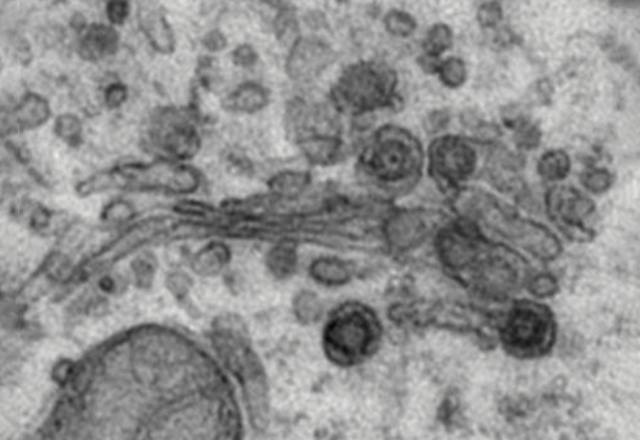 Thin section electron micrograph of a cell infected with the coronavirus infectious bronchitis virus showing virus particles assembling in a Golgi region. These virus particles will eventually be exported by vesicles to the cell surface where they are released. Credit: Carolyn Machamer, Johns Hopkins Medicine
Thin section electron micrograph of a cell infected with the coronavirus infectious bronchitis virus showing virus particles assembling in a Golgi region. These virus particles will eventually be exported by vesicles to the cell surface where they are released. Credit: Carolyn Machamer, Johns Hopkins Medicine
The Weird Way Coronaviruses Assemble Their Offspring
It'southward one of the tiniest machines on the planet — about a hundred times smaller than the average prison cell. Information technology'southward so small that no scientist can spot it through a typical lite microscope. Merely with an electron microscope can we see its spiky surface. It's non alive, and it's not what most of usa would recollect of as "expressionless." This teensy machine seems to survive in a kind of purgatory country, however it has traveled across continents and oceans from host to host, and brought hundreds of nations to a standstill.
Despite its atomic size, the novel coronavirus, dubbed SARS-CoV-2, has seemingly taken the world by surprise with its virulence. However, information technology's not a surprise to jail cell biologist Carolyn Machamer, who has studied viruses for the past 45 years. Understanding the complex interaction between viruses and the cells they infect tin help scientists develop amend means to forestall and treat the illnesses they crusade.
Read more than nearly how coronaviruses assemble
Date Posted: May six, 2020 | Disclaimer
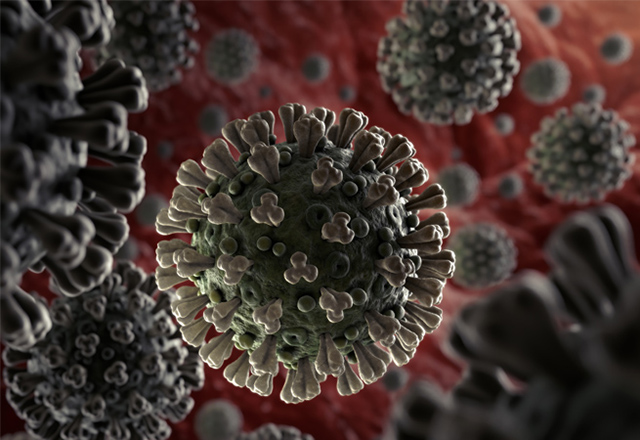
'Guidebook' Aims to Ramp Upwardly Capability for Blood Plasma Therapy for COVID-xix
A clinical guidebook is now bachelor to aid hospitals and medical centers speedily increase their power to deliver so-chosen convalescent plasma therapy, which leverages immune organization components found in the plasma portion of blood from people who take recovered from COVID-19.
Right now in that location are no therapies or effective vaccines for treating COVID-nineteen. The U.S. Food and Drug Administration has paved the way for researchers at Johns Hopkins to proceed with clinical trials to test ambulatory plasma therapy in people who are at high risk for severe COVID-nineteen and have been exposed to people who take tested positive for the virus that causes information technology.
Read more about the guidebook
Date Posted: May 6, 2020 | Disclaimer
More than Scientific discipline and Inquiry News
athertonluder1970.blogspot.com
Source: https://www.hopkinsmedicine.org/coronavirus/coronavirus-research/